
The Metropolitan Archdiocese of Baltimore is the premier see of the Latin Church of the Catholic Church in the United States. The archdiocese comprises the City of Baltimore and nine of Maryland's 23 counties in the central and western portions of the state: Allegany – Anne Arundel – Baltimore – Carroll, Frederick, Garrett–Harford, Howard, and Washington. The archdiocese is the metropolitan see of the larger regional Ecclesiastical Province of Baltimore. The Archdiocese of Washington was originally part of the Archdiocese of Baltimore.

Patrick Francis Healy was an American Catholic priest and Jesuit who was an influential president of Georgetown University, becoming known as its "second founder". The university's flagship building, Healy Hall, bears his name. Though he considered himself and was largely accepted as White, Healy was posthumously recognized as the first Black American to become a Jesuit, to earn a PhD, and to become the president of a predominantly White university.

The Archdiocese of Washington is a Latin Church ecclesiastical territory, or archdiocese, of the Catholic Church for the District of Columbia and several Maryland counties in the United States.

Louis William Valentine DuBourg was a French Catholic prelate and Sulpician missionary to the United States. He built up the church in the vast new Louisiana Territory as the Bishop of Louisiana and the Two Floridas and later became the Bishop of Montauban and finally the Archbishop of Besançon in France.
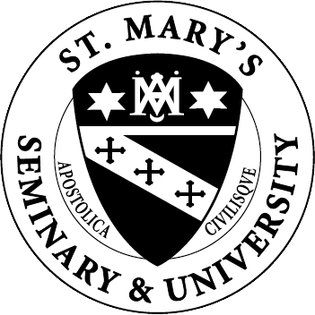
St. Mary's Seminary and University is a Catholic seminary located within the Archdiocese of Baltimore in Baltimore, Maryland; it was the first seminary founded in the United States after the Revolution and has been run since its founding by the Society of the Priests of Saint Sulpice.
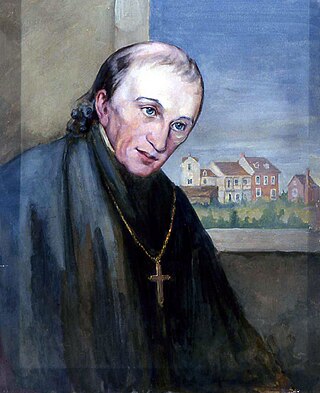
Leonard Neale was an American Catholic prelate and Jesuit who became the second Archbishop of Baltimore and the first Catholic bishop to be ordained in the United States. While president of Georgetown College, Neale became the coadjutor bishop to John Carroll and founded the Georgetown Visitation Monastery and Academy.

Healy Hall is a National Historic Landmark and the flagship building of the main campus of Georgetown University in Washington, D.C., United States. Constructed between 1877 and 1879, the hall was designed by Paul J. Pelz and John L. Smithmeyer, both of whom also designed the Thomas Jefferson Building of the Library of Congress. The structure was named after Patrick Francis Healy, who was the President of Georgetown University at the time.
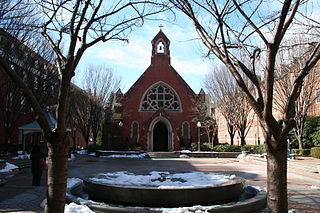
The history of Georgetown University spans nearly four hundred years, from the early European settlement of America to the present day. Georgetown University has grown with both its city, Washington, D.C., and the United States, each of which date their founding to the period from 1788 to 1790. Georgetown's origins are in the establishment of the Maryland colony in the seventeenth century. Bishop John Carroll established the school at its present location by the Potomac River after the American Revolution allowed for free religious practice.

John Carroll was an American prelate of the Catholic Church who served as the first bishop and archbishop in the United States. He served as the ordinary of the first diocese and later Archdiocese of Baltimore, in Maryland, which at first encompassed all of the United States and later after division as the eastern half of the new nation.
Jerome Aloysius Daugherty Sebastian was an American clergyman of the Roman Catholic Church. He served as an auxiliary bishop of the Archdiocese of Baltimore from 1954 until his death in 1960.
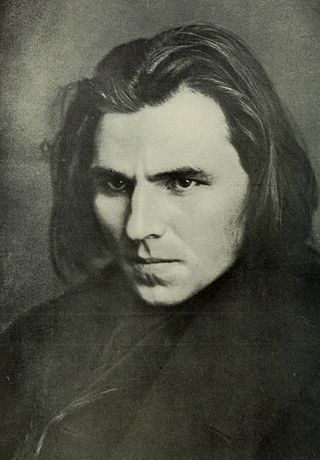
Jerome Connor was an Irish sculptor.

William Matthews, occasionally spelled Mathews, was an American who became the fifth Roman Catholic priest ordained in the United States and the first such person born in British America. Born in the colonial Province of Maryland, he was briefly a novice in the Society of Jesus. After being ordained, he became influential in establishing Catholic parochial and educational institutions in Washington, D.C. He was the second pastor of St. Patrick's Church, serving for most of his life. He served as the sixth president of Georgetown College, later known as Georgetown University. Matthews acted as president of the Washington Catholic Seminary, which became Gonzaga College High School, and oversaw the continuity of the school during suppression by the church and financial insecurity.
Anthony Caffry, sometimes spelled Caffrey and recorded in Vatican documents as McCaffrey, was an Irish Catholic priest who was a friar in the Order of Preachers. He is best known for being the founder and first pastor of St. Patrick's Church, the first Catholic church in Washington, D.C.
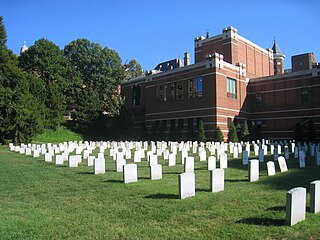
The Jesuit Community Cemetery on the campus of Georgetown University in Washington, D.C., is the final resting place for Jesuits who were affiliated with the university. It was first established in 1808 and was moved to its present location in 1854.
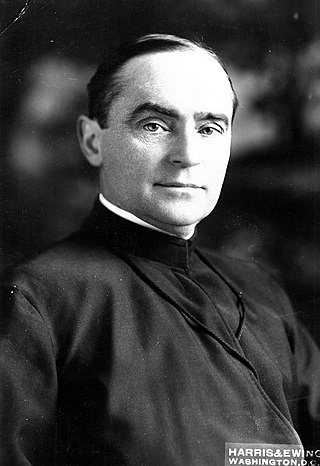
Alphonsus J. Donlon was an American Catholic priest and Jesuit who spent his career in priestly ministry and academia, including as president of Georgetown University from 1912 to 1918. Born in Albany, New York, he garnered a reputation as a good student and an exceptional collegiate athlete. As a professor, he went on to lead Georgetown University's sports program, which enjoyed great success. As a result, he became known as the "father of Georgetown athletics." He served as a professor of various sciences at Georgetown University and at Woodstock College, and as president of the former, he oversaw the removal of Georgetown Preparatory School from the university to a separate campus, and proposed the creation of the School of Foreign Service. For a significant portion of his career, he also served as a chaplain to Georgetown Visitation Monastery. In his later years, he engaged in pastoral work at St. Francis Xavier Church in New York City and taught at Fordham University.
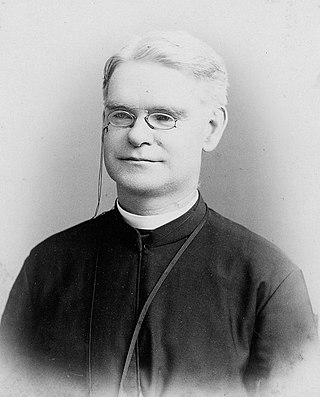
James Aloysius Doonan was an American Catholic priest and Jesuit, who was the president of Georgetown University from 1882 to 1888. During that time he oversaw the naming of Gaston Hall and the construction of a new building for the School of Medicine. Doonan also acquired two historic cannons that were placed in front of Healy Hall. His presidency was financially successful, with a reduction in the university's burdensome debt that had accrued during the construction of Healy Hall.
Enoch Fenwick was an American Catholic priest and Jesuit who ministered throughout Maryland and became the twelfth president of Georgetown College. Descending from one of the original Catholic settlers of the Province of Maryland, he studied at Georgetown College in what is now Washington, D.C. Like his brother and future bishop, Benedict Joseph Fenwick, he entered the priesthood, studying at St. Mary's Seminary before entering the Society of Jesus, which was suppressed at the time. He was made rector of St. Peter's Pro-Cathedral in Baltimore by Archbishop John Carroll, and remained in the position for ten years. Near the end of his pastorate, he was also made vicar general of the Archdiocese of Baltimore, which involved traveling to say Mass in remote parishes throughout rural Maryland.

Jerome Daugherty was an American Catholic priest and Jesuit who served in many different capacities at Jesuit institutions throughout the northeast United States, eventually becoming president of Georgetown University in 1901. Born in Baltimore, he was educated at Loyola College in Maryland, before entering the Society of Jesus and becoming a member of the first class at Woodstock College. He then taught various subjects, including mathematics, Latin, Ancient Greek, rhetoric, and the humanities in Massachusetts, New York City, and Washington, D.C., and served as minister at many of the institutions there.

John Dunning Whitney was an American Catholic priest and Jesuit who became the president of Georgetown University in 1898. Born in Massachusetts, he joined the United States Navy at the age of sixteen, where he was introduced to Catholicism by way of a book that accidentally came into his possession and prompted him to become a Catholic. He entered the Society of Jesus and spent the next twenty-five years studying and teaching mathematics at Jesuit institutions around the world, including in Canada, England, Ireland, and around the United States in New York, Maryland, Boston, and Louisiana. He became the vice president of Spring Hill College in Alabama before being appointed the president of Georgetown University.



























